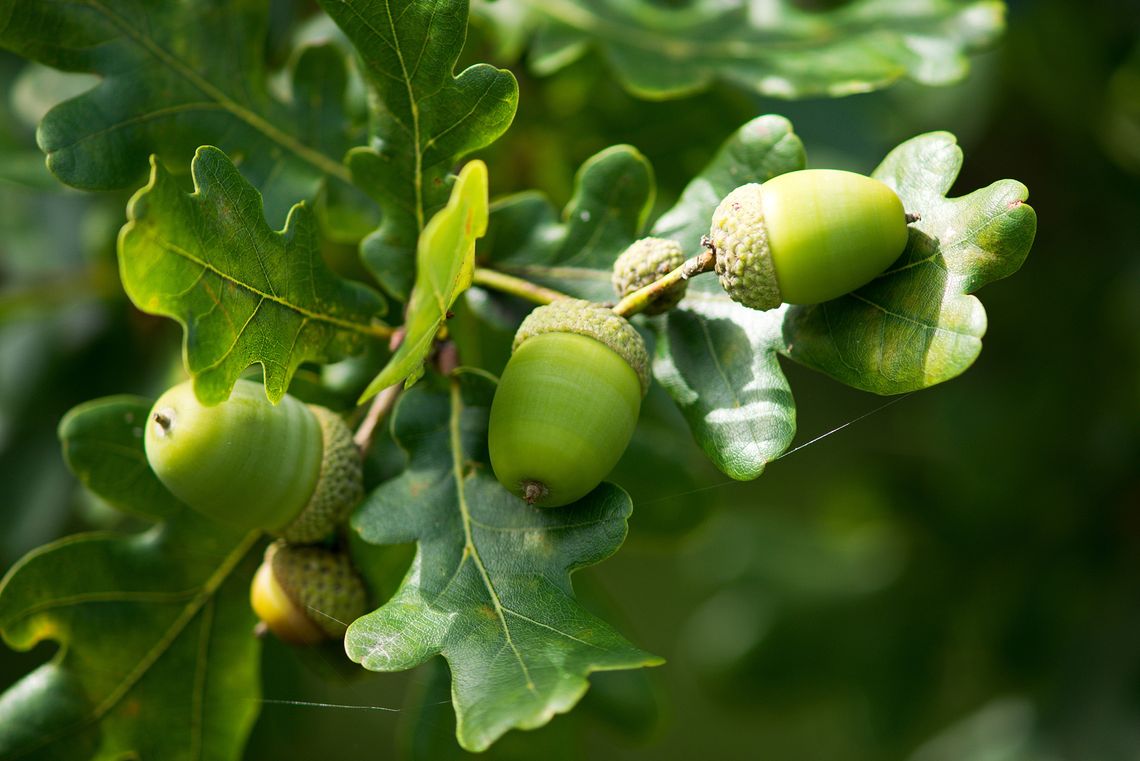Thirty-four different native oak species (and numerous hybrids) are found in Mississippi. Oaks are divided into two groups, red oak species and white oak species. There are several physiological differences regarding acorn production. One of the most distinctive differences between red oak and white oak is the length of time required to produce acorns. Red oak acorns take about 15 months (two growing seasons), and white oak acorns take three months, (one growing season) to mature. If you look closely at the twigs of red oak species, you will notice small, immature acorns on the current year’s growth and mature acorns on last years growth. The mature acorns were formed last year, and the smaller immature acorns will be next year’s crop. For this reason, sometimes red oak species have a good acorn crop, when white oak acorns are nearly nonexistent due to a late freeze earlier in the year.
In natural settings, oaks usually take somewhere in the neighborhood of 25-35 years to produce acorns consistently. However, acorn crops are highly inconsistent. This is from a variety of factors, including poor pollination, late spring freeze/frosts, drought, acorn weevil population levels, soil productivity, and genetic makeup of individual trees. While annual acorn production is difficult to predict, larger diameter trees with large crowns typically produce greater amounts of acorns than smaller diameter trees with smaller crowns.
Members of the oak genus are monoecious, meaning both male and female flowers are on the same tree. However, wind pollination and some variation in timing of male and female flowers on an individual tree ensures cross-pollination among nearby trees. Male flowers are pollen-producing stamens on catkins, and female flowers are the short spikes on the lead axils. For this reason, acorns are produced on the ends of twigs. Consequently, trees with large, well developed, exposed dominant or codominant crowns have a greater likelihood of being a good acorn producer compared to small-crowned, shaded trees.
Hard mast is a term that applies to the fruit (nuts) of oak (acorns), hickory, pecan, walnut, and beech trees. Hard mast is an important food source used by a variety of wildlife species, including white-tailed deer, wild turkeys, squirrels, ducks, and many non-game birds and mammals. While available primarily during the fall and winter months, acorns and nuts, are an important source of food for wildlife, and are available during a time when other food sources are not available.
Most folks concerned with increasing mast production for wildlife food are only concerned with increasing acorn production (oak species) and pay relatively little attention to other hard mast species (hickory, black walnut, beeches, etc). Many of these landowners attempt to supplement their properties with non-native oak species such as sawtooth oak in an effort to produce greater quantities of acorns during hunting seasons. While sawtooth oak has these attributes, the tree may not serve this role as well as some believe. Mississippi hunting seasons usually start in early October, and by then, the typical sawtooth acorn crop will either be gone or in the last stages of acorn drop. Most sawtooth trees start acorn drop in mid-August to early September and are finished by the time hunters enter the woods to hunt over the year’s crop.
Several native species can provide desired wildlife food sources while providing acorns during later periods of the year, which will be more beneficial to hunters and wildlife. An example is the Nuttall Oak. It is one of the fastest growing oak species in Mississippi, it drops acorns late in the fall and winter, (October through December), and has relative heavy mast crops. With fertilization and irrigation, acorns can be produced in as little as 5-10 years. Other oak species that should be considered as alternatives to sawtooth include swamp chestnut oak, Shumard oak, and others.


Comment
Comments